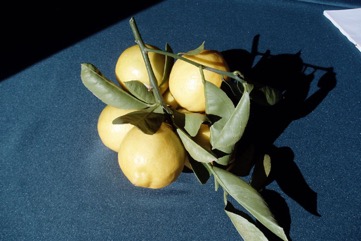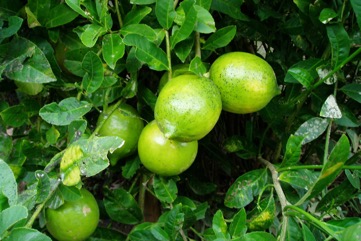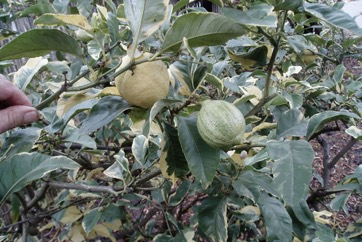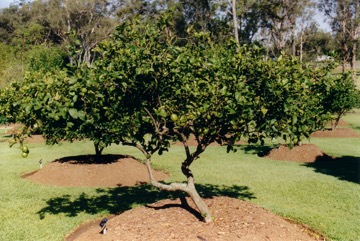Lemon

A subtropical plant. Trees do not do well on the coast in the tropics but they grow well at about 1300 m and will grow up to 2200 m altitude in Papua New Guinea. They prefer a light to medium, well drained soil. They are drought resistant but most varieties are frost tender. They need a temperature above 3-5°C for growth. They suit warm temperate regions. In Brisbane Botanical Gardens. It suits hardiness zones 9-11.
Also known as:
Baranebu, Baranibu, Bijapura, Bijapuram, Bijori, Citroen, Demmuda dadaara, Dhoalhanbu, Ennimu, Goranebu, Gulgul, Idalimbu, Jambira, Jambhoshi, Jatti khatti, Jhambheri, Kagizi, Khatta nabbu, Kro'ch chma' barang, Lala di ngani, Lebu, Lemun tsami, Limon, Moli karokaro, Moli witiwiti, Motulimbu, Mundino, Nemu, Nibuva, Nimbu, Ningmeng, Osan orombo, Osan wewe, Paharikaghzi, Paharinimbu, Periya yelumichai, Te remon, Than-bayo, Thoralimbu
Synonyms
- Citrus limonium Risso
- Citrus limonia Osbeck
- Citrus medica var. limonum L.
- Probably now Citrus x limon
Edible Portion
- Fruit, Herb, Spice, Flowers
Where does Lemon grow?
Found in: Africa, Asia, Australia, Bangladesh, Benin, Bhutan, Brazil, Burkina Faso, Cambodia, Cameroon, Caucasus, Central Africa, Central African Republic, CAR, Central America, China, Colombia, Congo DR, Cook Islands, Costa Rica, Côte d'Ivoire, Cuba, Cyprus, East Africa, Ethiopia, Europe, Fiji, Georgia, Ghana, Georgia, Greece, Guam, Guinea-Bissau, Guyana, Haiti, Hawaii, Himalayas, India, Indochina, Indonesia, Italy, Ivory Coast, Kenya, Kiribati, Korea, Laos, Lebanon, Madagascar, Malawi, Malaysia, Maldives, Malta, Mediterranean, Mexico, Micronesia, Morocco, Mozambique, Myanmar, Nauru, Nepal, New Caledonia, Niger, Nigeria, North Africa, Northeastern India, Pacific, Pakistan, Palau, Papua New Guinea, PNG, Peru, Philippines, Rotuma, Sao Tome and Principe, Saudi Arabia, SE Asia, Sierra Leone, Slovenia, Solomon Islands, South Africa, Southern Africa, South America, Spain, Sri Lanka, Suriname, Taiwan, Tajikistan, Tanzania, Thailand, Tonga, Turkey, Tuvalu, Uganda, United Arab Emirates, UAE, United States, Vanuatu, Vietnam, West Africa, Zambia, Zimbabwe
Notes: There are 20 Citrus species. Several hybrids have been formed.
Status: Less common than West Indian limes on the coast in Papua New Guinea but more common in highland areas.
Growing Lemon
Cultivation: Many trees are seedlings. Better trees are grafted.
Edible Uses: The fruit is mostly too sour to eat fresh but the juice is used to make drinks. The juice is used in tea, ice cream, sauces, salads, salad dressings and marinades. It can be a coagulant in cheese making. The peel is used as seasoning in chocolate. The peel is candied in syrup. The inner parts of the peel and pulp are used for low-methoxyl pectins used for sugarless fruit jams and jellies. The dried leaves are added to teas for flavouring. The flowers are eaten in ice cream, fritters and jams. Caution: Large doses can erode teeth enamel and cause dermatitis.
Nutrition Info
per 100g edible portion| Edible Part | Energy (kcal) | Protein (g) | Iron (mg) | Vitamin A (ug) | Vitamin c (mg) | Zinc (mg) | % Water |
|---|---|---|---|---|---|---|---|
| Fruit whole fruit | 15 | 1.1 | 0.4 | Tr | 80 | 0.1 | 83.3 |
| Fruit fresh Juice | 7 | 0.3 | 0.1 | Tr | 50 | Tr | 91.3 |
Lemon Photos




References
AAK, 1994, Jeruk, Penerbit Kanisius, Jogyakarta. p 198
Abbiw, D.K., 1990, Useful Plants of Ghana. West African uses of wild and cultivated plants. Intermediate Technology Publications and the Royal Botanic Gardens, Kew. p 42
Ambasta, S.P. (Ed.), 2000, The Useful Plants of India. CSIR India. p 128
Ashton, M. S., et al 1997, A Field Guide to the Common Trees and Shrubs of Sri Lanka. WHT Publications Ltd. pdf p 345
Baishya, S. Kr., et al, 2013, Survey of Wild Edible Fruits of Dhubri District, Assam, India. Plant Archives Vol 13 (1): 155-158
Barwick, M., 2004, Tropical and Subtropical Trees. A Worldwide Encyclopedic Guide. Thames and Hudson p 117
Bernholt, H. et al, 2009, Plant species richness and diversity in urban and peri-urban gardens of Niamey, Niger. Agroforestry Systems 77:159-179
Bianchini, F., Corbetta, F., and Pistoia, M., 1975, Fruits of the Earth. Cassell. p 184
Blamey, M and Grey-Wilson, C., 2005, Wild flowers of the Mediterranean. A & C Black London. p 123
Bodkin, F., 1991, Encyclopedia Botanica. Cornstalk publishing, p 261
Bourret, D., 1981, Bonnes-Plantes de Nouvelle-Caledonie et des Loyaute. ORSTOM. p 29
Brickell, C. (Ed.), 1999, The Royal Horticultural Society A-Z Encyclopedia of Garden Plants. Convent Garden Books. p 272
Brouk, B., 1975, Plants Consumed by Man. Academic Press, London. p 307
Brown, D., 2002, The Royal Horticultural Society encyclopedia of Herbs and their uses. DK Books. p 172
Burkill, H. M., 1985, The useful plants of west tropical Africa, Vol. 4. Kew.
Burkill, I.H., 1966, A Dictionary of the Economic Products of the Malay Peninsula. Ministry of Agriculture and Cooperatives, Kuala Lumpur, Malaysia. Vol 1 (A-H) p 575
Bussman, R. W., et al, 2016, A comparative ethnobotany of Khevsureti, Samtskhe-Javakheti, Tusheti, Svaneti, and Racha-Lechkhumi, Republic of Georgia (Sakartvelo), Caucasus. Journal of Ethnobiology and Ethnomedicine.
Bussman, R. W. et al, 2017, Ethnobotany of Samtskhe-Javakheti, Sakartvelo (Republic of Georgia), Caucasus. Indian Journal of Traditional Knowledge Vol. 16(1) pp 7-24
Call, C. A., et al, 2004, Participatory Rural Appraisal in the Upland Ecosystem of Mt Malindang, Misamis Occidental, Philippines. Biodiversity Research Programme for Development in Mindanao. p 60
Cameron, J.W. & Soost, R.K., 1979, Citrus, in Simmonds, N.W., (ed), Crop Plant Evolution. Longmans. London. p 261
Chandrashekara, U. M., 2009, Tree species yielding edible fruit in the coffee-based homegardens of Kerala, India: their diversity, uses and management. Food Sec. 1:361-370
Catarino, L., et al, 2016, Ecological data in support of an analysis of Guinea-Bissau's medicinal flora. Data in Brief 7 (2016):1078-1097
Cheifetz, A., (ed), 1999, 500 popular vegetables, herbs, fruits and nuts for Australian Gardeners. Random House p 180
Chin, H.F., & Yong, H.S., 1996, Malaysian Fruits in Colour. Tropical press, Kuala Lumpur p 51
Clarke, W.C. & Thaman, R.R., 1993, Agroforestry in the Pacific Islands: Systems for sustainability. United Nations University Press. New York. p 230
Cobley, L.S. (rev. Steele, W.M.) 2nd Ed., 1976, An Introduction to the Botany of Tropical Crops. Longmans. p 166
Coronel, R.E., 1982, Fruit Collections in the Philippines. IBPGR Newsletter p 6
Cribb, A.B. & J.W., 1976, Wild Food in Australia, Fontana. p 25
Cruz, I. M., et al, 2015, Edible fruits and seeds in the State of Mexico. Revista Mexicana de Ciencias Agricolas. Vol. 6. Num. 2 pp 331-346
Cundall, P., (ed.), 2004, Gardening Australia: flora: the gardener's bible. ABC Books. p 384
Das, T. & Das, A. K., 2005, Inventorying plant biodiversity in homegardens: A case study in Barak Valley, Assam, North East India. CURRENT SCIENCE, VOL. 89, NO. 1, 10 JULY 2005
Elevitch, C.R.(ed.), 2006, Traditional Trees of the Pacific Islands: Their Culture, Environment and Use. Permanent Agriculture Resources, Holualoa, Hawaii. p 245
Etherington, K., & Imwold, D., (Eds), 2001, Botanica's Trees & Shrubs. The illustrated A-Z of over 8500 trees and shrubs. Random House, Australia. p 215
Facciola, S., 1998, Cornucopia 2: a Source Book of Edible Plants. Kampong Publications, p 217
Fl. indica 173. 1768
Flora of Pakistan. www.eFloras.org
Fowler, D. G., 2007, Zambian Plants: Their Vernacular Names and Uses. Kew. p 59
Fox, F. W. & Young, M. E. N., 1982, Food from the Veld. Delta Books. p 329 (As Citrus medica var. limonum)
Franklin, J., Keppel, G., & Whistler, W., 2008, The vegetation and flora of Lakeba, Nayau and Aiwa Islands, Central Lau Group, Fiji. Micronesica 40(1/2): 169–225, 2008
French, B.R., 1986, Food Plants of Papua New Guinea, A Compendium. Asia Pacific Science Foundation p 227
French, B.R., 2010, Food Plants of Solomon Islands. A Compendium. Food Plants International Inc. p 228
Goode, P., 1989, Edible Plants of Uganda. FAO p 27
Gurdal, B. & Kultur, S., 2014, The edible and miscellaneous useful plants in Marmaris (Southwest Turkey). İstanbul Ecz. Fak. Derg. / J. Fac. Pharm. Istanbul 44(1) 2014 pp.69-78
Hearne, D.A., & Rance, S.J., 1975, Trees for Darwin and Northern Australia. AGPS, Canberra p 46
Hiddins, L., 1999, Explore Wild Australia with the Bush Tucker Man. Penguin Books/ABC Books. p 132
Hu, Shiu-ying, 2005, Food Plants of China. The Chinese University Press. p 492
Jardin, C., 1970, List of Foods Used In Africa, FAO Nutrition Information Document Series No 2.p 128
John, L., & Stevenson, V., 1979, The Complete Book of Fruit. Angus & Robertson p 171
Kahlon, L. K. & Singh, R., 2019, Traditional knowledge & Dynamics of edible plants of primitive tribal group ‘Paudi Bhuyan’ with changing demography migration patterns in Northern Odisha. Indian Journal of Traditional Knowledge Vol 18(1), pp 7-15
Khanal, R., et al, 2014, Documenting abundance and use of underutilized plant species in the mid hill region of Nepal. ECOPRINT 21: 63-71, 2014
Kiple, K.F. & Ornelas, K.C., (eds), 2000, The Cambridge World History of Food. CUP p 433, 1800
Kybal, J., 1980, Herbs and Spices, A Hamlyn Colour Guide, Hamlyn Sydney p 76
Katende, A.B., Birnie, A & Tengnas B., 1995, Useful Trees and Shrubs for Uganda. Identification, Propagation and Management for Agricultural and Pastoral Communities. Technical handbook No 10. Regional Soil Conservation Unit, Nairobi, Kenya. p 186
Lazarides, M. & Hince, B., 1993, Handbook of Economic Plants of Australia, CSIRO. p 61
Lorenzi, H., Bacher, L., Lacerda, M. & Sartori, S., 2006, Brazilian Fruits & Cultivated Exotics. Sao Paulo, Instituto Plantarum de Estuados da Flora Ltda. p 538
Lyle, S., 2006, Discovering fruit and nuts. Land Links. p 132
Macmillan, H.F. (Revised Barlow, H.S., et al) 1991, Tropical Planting and Gardening. Sixth edition. Malayan Nature Society. Kuala Lumpur. p 277
Manandhar, N.P., 2002, Plants and People of Nepal. Timber Press. Portland, Oregon. p 156
Mbuya, L.P., Msanga, H.P., Ruffo, C.K., Birnie, A & Tengnas, B., 1994, Useful Trees and Shrubs for Tanzania. Regional Soil Conservation Unit. Technical Handbook No 6. p 178
Medhi, P. & Borthakur, S. K., 2012, Phytoresources from North Cachur Hills of Assam -3: Edible plants sold at Hflong market. Indian Journal of Natural Products and Resources. 3(1) pp 84-109
Miguel, E., et al, 1989, A checklist of the cultivated plants of Cuba. Kulturpflanze 37. 1989, 211-357
Molla, A., Ethiopian Plant Names. http://www.ethiopic.com/aplants.htm
Morton, J. F., 1987, Fruits of Warm Climates. Wipf & Stock Publishers p 160
Mulherin, J., 1994, Spices and natural flavourings. Tiger Books, London. p 103
Murtem, G. & Chaudhrey, P., 2016, An ethnobotanical note on wild edible plants of Upper Eastern Himalaya, India. Brazilian Journal of Biological Sciences, 2016, v. 3, no. 5, p. 63-81.
Omawale, 1973, Guyana's edible plants. Guyana University, Georgetown p 26
Partha, P., 2014, Ethnobotany of the Laleng (Patra) Community in Bangladesh. Journal of Pharmacognosy and Phytochemistry. 2(6):173-184
Phon, P., 2000, Plants used in Cambodia. © Pauline Dy Phon, Phnom Penh, Cambodia. p 159
Plants for a Future database, The Field, Penpol, Lostwithiel, Cornwall, PL22 0NG, UK. http://www.scs.leeds.ac.uk/pfaf/
Plants of Haiti Smithsonian Institute http://botany.si.edu/antilles/West Indies
PROSEA handbook Volume 13 Spices. p 275
PROSEA (Plant Resources of South East Asia) handbook, Volume 2, 1991, Edible fruits and nuts.
Purseglove, J.W., 1968, Tropical Crops Dicotyledons, Longmans. p 502
Rosero-Toro, et al, 2018, Cultural significance of the flora of a tropical dry forest in the Doche vereda (Villavieja, Huila, Colombia). Journal of Ethnobiology and Ethnomedicine (2018) 14:22 p 12
Ruiters-Welcome, A. K., 2019, Food plants of southern Africa. Ph.D. thesis. Univ. of Johannesburg p 98
Segnon, A. C. & Achigan-Dako, E. G., 2014, Comparative analysis of diversity and utilization of edible plants in arid and semi-arid areas in Benin. Journal of Ethnobiology and Ethnomedicine 2014, 10:80
Segura, S., et al, 2018, The edible fruit species in Mexico. Genet Resour Crop Evol (2018) 65:1767–1793
Seidemann J., 2005, World Spice Plants. Economic Usage, Botany, Taxonomy. Springer. p 107
Selvam, V., 2007, Trees and shrubs of the Maldives. RAP Publication No. 2007/12 p 66
Small, E., 2009, Top 100 Food Plants. The world's most important culinary crops. NRC Research Press. p 309
Staples, G.W. and Herbst, D.R., 2005, A tropical Garden Flora. Bishop Museum Press, Honolulu, Hawaii. p 503
Sujanapal, P., & Sankaran, K. V., 2016, Common Plants of Maldives. FAO & Kerala FRI, p 80
Thaman, R.R., 1976, The Tongan Agricultural System, University of the South Pacific, Suva, Fiji. p 389
Thaman, R. R, 2016, The flora of Tuvalu. Atoll Research Bulletin No. 611. Smithsonian Institute p 112
Tredgold, M.H., 1986, Food Plants of Zimbabwe. Mambo Press. p 94
USDA, ARS, National Genetic Resources Program. Germplasm Resources Information Network - (GRIN). [Online Database] National Germplasm Resources Laboratory, Beltsville, Maryland. Available: www.ars-grin.gov/cgi-bin/npgs/html/econ.pl (10 April 2000)
van Wyk, B., 2005, Food Plants of the World. An illustrated guide. Timber press. p 140
Vickery, M.L. and Vickery, B., 1979, Plant Products of Tropical Africa, Macmillan. p 43
Walter, A. & Lebot, V., 2007, Gardens of Oceania. ACIAR Monograph No. 122. p 132
Williamson, J., 2005, Useful Plants of Malawi. 3rd. Edition. Mdadzi Book Trust. p 67
Young, J., (Ed.), 2001, Botanica's Pocket Trees and Shrubs. Random House. p 251